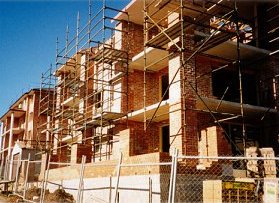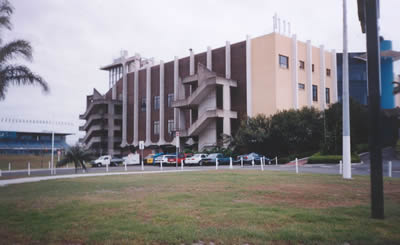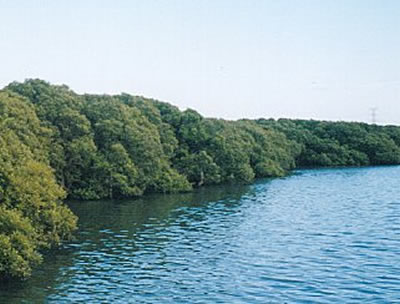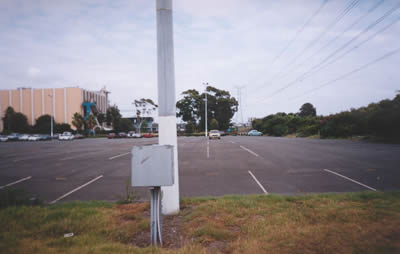|
|
Five Strong Objections to Residential Areas
on a Club-and-Football Site |
1. A truly disastrous precedent
Disastrous, that is, for historic Kurnell Peninsula. Nor is
disastrous too strong a word. Sutherland Shire Council's
Environmental Services, in its 40-page Report of 20 January
2003 on the Sharks Proposal, says bluntly:
"Due
to its size and the location of the site, this will be a landmark
development. It follows that it will also establish a benchmark
for future major developments." (p.16)
Alarmed by this, the coalition of eight community organisations,
Kurnell Regional Environment Planning Council (KREPC), at once
addressed a News Release to Shire Councillors, saying they were
confronted by "an awesome responsibility":
"At stake is the future of the Kurnell Peninsula, where
sandmining, industrial and residential activities have damaged
much of the fragile environment of this most historic area,
where Cook and Phillip first landed.
If sanctioned... the Sharks' development will at once create
a precedent for other major developments: first, the even larger
500-dwellings Australand project (only a kilometre from the
Sharks' site), and then development on the big landholdings
of the Breen and Holt companies.
The Sharks' development - including five high-rise buildings
on the edge of Woolooware Bay (part of Botany Bay) - would be
the largest single residential development in the Shire's history...
In short, Councillors do indeed face an awesome decision on
Kurnell's future, one comparable to the Council decision in
the 1930s which brought destruction to the Kurnell sandhills."
And the KREPC statement added: "The proposal comes
at the very time Councillors are to place before the Shire community
a 'People's Local Environment Plan' intended to arrest overdevelopment
- and it therefore contradicts Council's intention." |
|
| Top of Page |
2. A
gross overdevelopment
"The current proposal is a gross overdevelopment and
is inconsistent with several directions and policies of Council."-
This is the conclusion reached by Sutherland Shire Council's
Environmental Services in its Report on the Sharks Proposal
of 20 January 2003 (p.35).
In other words, the Proposal is seen to conflict flatly with
the 'curb-overdevelopment' policy on which the present Council
was elected in 1999.
It conflicts, most obviously, with The People's Local Environment
Plan (LEP) which Council has proudly placed on public exhibition
between 18 February and 30 April 2003, by unanimous decision
of the 15 Councillors. |
 |
'Gross overdevelopment' explained
"Overdevelopment" is too much development occurring
in any location. Offending against the character of a locality,
it is often condemned also as "inappropriate" and
marked by congestion of buildings and traffic.
"Gross overdevelopment", in the case of the
Sharks Proposal, is indicated by:
- High density: the crowding of five large residential
buildings onto the relatively small club carpark site.
- High rise: four of the five buildings, ranging
from 4 to 7 levels, are higher than the roof of the existing
tall building (below).
|
 |
At odds with 'The People's LEP'
The Shire's Local Environment Plan (LEP) is what guides the
Council's Environmental Services in judging the appropriateness
of every development application - whether it is suitable to
a given locality.
The new 'People's LEP' has been two years in the making, at
a cost of $700,000. Scores of meetings of councillors, planners,
consultants and community people have forged it. Key policies
of these meetings included:
- curb overdevelopment wherever it might be proposed;
- allow some concentration only around main rail centres;
- limit waterfront building height to two storeys;
- avoid or scale down proposed waterfront development;
- insist on spacious landscaping between multi-storey
buildings;
- site aged accommodation near shops and public transport.
The Sharks Proposal is at odds with all six of these LEP
criteria. |
| Top of Page |
3. A
Source of Traffic Problems
The Sharks' development site is "considerably remote from
major centres" and is therefore "in direct conflict"
with Shire Council's policies of only promoting "higher
density forms of residential development around commercial centres/transport
nodes".
- so says Sutherland Council's Environmental Services Report,
20 January 2003 (p.33).
The roads around the Sharks Club are regularly busy and are
often congested on football game-days and summer weekends. Popular
game-days, indeed, can bring traffic to chaos level in the Woolooware-North
Cronulla area. There are many reasons why this 210-unit development
will worsen the congestion. |
 |
- The site is not within reasonable walking distance of
Woolooware Railway Station (over 1 kilometre away).
- The commercial centres - Cronulla, Caringbah and Miranda
- are much further distant and so demand vehicle conveyance.
- With no rail available, the only feasible "public
transport" is by bus, which raises all the problems
of bus frequency felt acutely in most areas of the Shire.
- The 210 residential units, plus 60-suite hotel, plus other
facilities, all add up to high traffic levels for 16 hours
a day, 7 days a week.
- Residents of Kurnell will feel keenly the rise in vehicle
numbers on Captain Cook Drive which is their only access
and which is already burdened by the daily movement of over
600 big sand and waste-carrying trucks (see picture above).
- Council's Community Services Officers have warned that
the combination of higher road usage and lack of public
transport may increase traffic offences, while higher numbers
of pedestrians (not least those from over-55s units) may
conflict with hotel patrons and alcohol-affected drivers.
(p.24)
|
| Top of Page |
4. A
blow to the Bay/Kurnell environment
Sensitive? Indeed! The Sharks' Club and grounds sit along
the edge of Woolooware Bay, one of the Shire's largest and finest
waterways, a sub-bay of Botany Bay and part of Kurnell Peninsula.
The National Parks Association has warned: "The site is
in an area of extreme environmental sensitivity, bordering as
it does a significant mangrove foreshore and the Taren Point
wetlands and Towra Point Aquatic Reserve". |
 |
Contrary to Council and NSW Government direction
On the protection of Botany Bay/Kurnell, Sutherland Council's
Environmental Services Report of 20 January says: "For
several years Council has been urging the NSW Government to
have greater regard for the environmental sensitivity of the
Kurnell Peninsula and Botany Bay. The NSW Government has responded
by initiating several reviews and studies intended to establish
new policies that guarantee the future of the area. [The Sharks]
development of the site to the scale proposed would be contrary
to the direction currently being pursued by Council and the
NSW Government." (p.4)
Natural area v. Dense
population. Shifting a large population into a natural area
has always and everywhere led to decline or disaster for nature.
Even if the Sharks Club carries out a promise to protect the
natural environment, its massive development can't possibly
guarantee full effectiveness in containing the impacts on the
Bay, the mangroves and the groundwater moving through the sandy
site: that is, impacts from the large population they propose
to shift into five tall buildings on the present carpark area
- inevitable impacts from detergents, pesticides, fertilisers,
weeds, excreta from pets, assorted litter and vandalism. And
add to those the vehicle-caused pollution that will attend greatly
increased vehicle use.
Two huge obstacles to the Proposal
- A foreshore protection zone (buffer). A protective
zone or buffer or setback is essential between the Bay and
the proposed built area. But its width is in serious dispute.
NSW Fisheries, supported by environmentalists, want 100
metres. Other authorities recommend 50 metres. In the past,
a common expectation for such a foreshore has been 30 metres,
and the Sharks Proposal acknowledges this. Even so, critical
questions remain...
|
 |
Setback from what point: from mean high water
mark? or from the land-side line of mangroves? If Council
planners would accept 30 metres as adequate for a 2-storey
waterfront structure, would they accept it for the five proposed
4-7 storey buildings? Surely not.
And should the buffer zone be entirely vegetated with native
plants? Should cycling and walking tracks be accepted on it?
Should an easement for undergrounding of the electricity transmission
lines be permitted beneath it? Probably not.
Disputes over the buffer zone will only be settled when the
NSW Government concludes the Botany Bay Strategy Study it
launched on 3 September 2002 - that is, settled by the criteria
the Government proclaims as the standard with which all developments
throughout Botany Bay must conform.
- Release of acid poison by soil disturbance. A
great danger in all excavation near coastal waterways is
the release of acid sulfate, which has remained stable in
soil that is saturated (by groundwater) but is at once released
into a waterway when the soil is disturbed by excavation
- with devastating effects for fish, prawns, crabs and other
aquatic life. This must be an especial concern for Woolooware
Bay because it is part of an Aquatic Reserve with links
to Towra Point Nature Reserve and Taren Point Wetlands.
Sutherland Shire Council specifically refuses "development
consent" (under Clause 22, SSLEP 2000) when a developer's
precautions against acid sulfate-release are inadequate.
Which is what Council's Environmental Services Report (p.20)
has found the Sharks Proposal to be:
"... there has been no quantification of potential
acid generation from the works and no certainty in the generic
mitigating measures restricting the release of acid water
to the environment. Therefore the [Proposal] does not satisfy
the requirement of [Council's] Clause 22..."
Very extensive excavation will certainly be needed if the
Sharks Proposal goes ahead - for digging out the old rubbish
tip beneath the building site, for the sinking of foundations
of the 5 big buildings, for laying down the base of the
2-level carpark, and for the undergrounding of the electricity
transmission lines.
|
| Top of Page |
5. An
obvious case of inappropriate development
Today, "overdevelopment" is widely condemned throughout
Sydney - and "inappropriate development" is even more
widely condemned, because instances of it are more visible and
no less widespread.
The Sharks "210" residential Proposal is so obvious
a case of inappropriate development that it is not difficult
to find...
21 reasons why the proposed development is inappropriate
Keep in mind that the NSW Government has issued PlanFirst,
its urban planning guide for councils, which asserts the primacy
of "localities", so that any new development must
show that it is in harmony with "the character of the locality
in which it will be located".
- The Sharks Proposal of 5 large, closely clustered buildings
housing 210 families has nothing in common with the low
density of Woolooware locality.
- The proposed development is in stark contrast to the sensitive
open, natural waterfront environment of lovely Woolooware
Bay.
- The design of the new cluster of tall buildings, like
the design of the existing club, has been dismissed by architects
as "unsympathetic" to the natural setting.
- The development would impact on the nearby, significant,
internationally recognised wetlands of Towra Point and Taren
Point (e.g. used by migratory birds).
- To provide a buffer/setback between buildings and bay,
Fisheries Department recommends 100 metres, but the Sharks
want no more than 30 metres.
- Unavoidable excavations (for foundations, etc.) are likely
to stir up the acid sulfate levels in the soil, releasing
poisonous acid into the bay's "aquatic reserve".
- The proposed 2-level carpark is likely to intrude into
the groundwater table, with polluting effects for adjacent
areas.
- Visually, the cluster of tall buildings will clash offensively
with the natural - green and marine - character of Woolooware
Bay.
- The development will be a severe reverse for the Shire's
often-expressed intention to preserve remaining natural
and open-space areas.
- The 20 ha football-and-club site beside the Bay was approved
in the 1960s when environmental awareness was slight; today,
expanded development is inexcusable.
- The Proposal has been widely and authoritatively condemned
as a "gross overdevelopment" and as "inappropriate
development".
- It conflicts completely with the spirit and many provisions
of Sutherland Shire Council's new People's Local Environment
Plan (LEP).
- As the largest single residential development in the Shire's
history, the Proposal, if realised, would enshrine "overdevelopment".
- It would be larger than the combined size of two
often-criticised giants, Northies Hotel at Cronulla, Meriton's
Gateway Units at Caringbah.
- All of the Proposal's 5 residential buildings are taller
than is favoured for unit-building by Council's new LEP.
- The 5 buildings are closely clustered, conflicting with
the new LEP's push for open-space/landscaping between buildings.
- The 5 buildings concentrate a population in an area which
is remote from shopping centres and
rail stations.
- This expanded population will worsen local traffic problems,
especially the congestion on sporting game-days and summer
weekends.
- The cluster of 5 buildings - 210 households - lacks its
own communal facilities (separate from those that must be
turned to within the Club building).
- The site is especially unsuitable for older persons' housing,
being isolated from shops/services/rail and subject to noise/traffic/game-day
problems.
- The Proposal is at odds with the historic/heritage values
of Kurnell Peninsula, "Birthplace of Modern Australia",
which needs restoration of the natural environment.
Council and community are obliged to call on the Sharks Club
as "a good corporate citizen" to contribute along
with community, Council and NSW Government to the rehabilitation
of the Kurnell Peninsula and especially to the health of Woolooware
Bay and what's left of the nearby Cronulla-Wanda sandhills. |
| Top of Page |
| |
|

